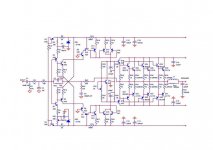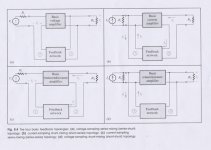Neither my CFB amplifier is typical topology nor I am very experienced listener (I think), but you can expect nice, natural cymbals and percussion from some CFB amps. Also brass and violins sound very natural. And bass is OK also.
regards
regards
pinkmouse said:Mikeks, if you are going to post purely negatively, with absolutely no contribution to a debate, then please don't bother posting at all.
PM...there is nothing to recommend so-called 'current feedback' in audio applications, unless such a topology is used as part of a compound output stage with gain in excess of unity.

Peranders
I looked at your site.
How do you achieve 1200V/us slew with 100pF capasitor to ground as compensation?
Charging current seems to be 120mA if my calculation is OK. High...
I looked at your site.
How do you achieve 1200V/us slew with 100pF capasitor to ground as compensation?
Charging current seems to be 120mA if my calculation is OK. High...
Hi PMA
---I would respectfully disagree.---
The thread I mentionned pointed the fact that "current feedback" is a very confusing terminology. I do not say technically it was any bad nor any good. For me, the "current feedback" scheme is as old as feedback returned to the cathode of the input device in valve amplifiers.
---Don't look at DIY discussions---
What's the forum for, then ?
To me it was a very enlightning discussion because there were so many conflicting points of view and because I saw Baxandall's name quoted.
---I would respectfully disagree.---
The thread I mentionned pointed the fact that "current feedback" is a very confusing terminology. I do not say technically it was any bad nor any good. For me, the "current feedback" scheme is as old as feedback returned to the cathode of the input device in valve amplifiers.
---Don't look at DIY discussions---
What's the forum for, then ?
To me it was a very enlightning discussion because there were so many conflicting points of view and because I saw Baxandall's name quoted.
mikeks said:PM...there is nothing to recommend so-called 'current feedback' in audio applications, unless such a topology is used as part of a compound output stage with gain in excess of unity.
Why?
ash_dac said:
CFA's disadvantages:-
-poor precision
-poor common mode rejection (due to mismatched input impedances)
-poor powersupply rejection
-difficult to apply (stray capacitance..)
The 'advantages' below are readily obtained by with the traditionalvoltagefeedback configuraton..
ash_dac said:
CFA's advantages:-
-high slew rate
-wide bandwidth
http://www.diyaudio.com/forums/showthread.php?s=&threadid=36563&highlight=
my "small" perspective on CFB opamps -- but this thread is tending toward higher current stuff -- you can do applications with CFB opamps that are unapproachable with VFB opamps -- but you have to be very careful in layout and resistor selection. as a matter of fact, everything seems to revolve around Rf and Rg. CFB opamps don't run out of gain.
Hi ANALOG GUY,
Your schematics seems very similar to a circuit from Stan Curtis used in the first Mission Amplifier, a Lecson amplifier and a DIY class A project published in ETI.
Your schematics seems very similar to a circuit from Stan Curtis used in the first Mission Amplifier, a Lecson amplifier and a DIY class A project published in ETI.
mikeks said:
Not true...
As far as I remember you don'teven accept there are such things as CFB amps, so how can you have an opinion on their properties? 😉
That said, I also find Jacks comment puzzling and asking for a clarification.
Christer said:As far as I remember you don't even accept there are such things as CFB amps...
Actually, this also is incorrect.....current feedback amps DO exist, as a matter of fact.
These, by definition, possess series (current) derived-shunt (current) applied negative feedback.
The so-called 'current-feedback' topology is, in fact, merely shunt (voltage) derived-series (voltage) applied negative feedback implemented with an unusually low-impedance feedback voltage divider.
mikeks said:
Actually, this also is incorrect.....current feedback amps DO exist, as a matter of fact.
These, by definition, possess series (current) derived-shunt (current) applied negative feedback.
The so-called 'current-feedback' topology is, in fact, merely shunt (voltage) derived-series (voltage) applied negative feedback implemented with an unusually low-impedance feedback voltage divider.
OK, but that is the usual confusion with conflicting terminologies, and I assume your previous comment was referring to what others call CFB in this thread and which you do not acknowledge as different from VFB, or have I entirely misunderstood our previous lengthy discussions on this topic? Oh well, I don't want to start those discussion over again. 🙂
Christer said:.....I assume your previous comment was referring to what others call CFB in this thread and which you do not acknowledge as different from VFB.........
Correct..
mikeks said:
Correct..
Which means you post was strange since since you commented on the properties of something that doesn't exist according to you. 😉
Christer said:
Which means you post was strange since since you commented on the properties of something that doesn't exist according to you. 😉
What 'doesn't exist' is in fact a variation on voltage feedback....Get it?🙄
mikeks said:
Actually, this also is incorrect.....current feedback amps DO exist, as a matter of fact.
These, by definition, possess series (current) derived-shunt (current) applied negative feedback.
The so-called 'current-feedback' topology is, in fact, merely shunt (voltage) derived-series (voltage) applied negative feedback implemented with an unusually low-impedance feedback voltage divider.
This is also the definition I was tought.....
\Jens
Attachments
- Status
- Not open for further replies.
- Home
- Amplifiers
- Solid State
- Current feedback - not suitable for audio ?

